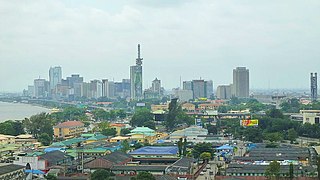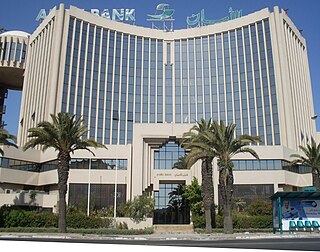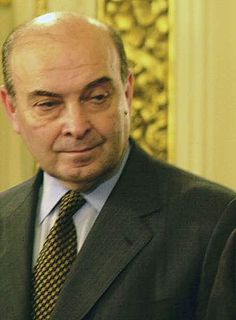
The economy of Djibouti is derived in large part from its strategic location on the Red Sea. Djibouti is mostly barren, with little development in the agricultural and industrial sectors. The country has a harsh climate, a largely unskilled labour force, and limited natural resources. The country's most important economic asset is its strategic location, connecting the Red Sea and the Gulf of Aden. As such, Djibouti's economy is commanded by the services sector, providing services as both a transit port for the region and as an international transshipment and refueling centre.

The economy of Morocco is considered a relatively liberal economy, governed by the law of supply and demand. Since 1993, Morocco has followed a policy of privatization of certain economic sectors which used to be in the hands of the government. Morocco has become a major player in African economic affairs, and is the 5th largest African economy by GDP (PPP). The World Economic Forum placed Morocco as the 1st most competitive economy in North Africa, in its African Competitiveness Report 2014–2015.

The economy of Nigeria is a middle-income, mixed economy and emerging market, with expanding manufacturing, financial, service, communications, technology, and entertainment sectors. It is ranked as the 27th-largest economy in the world in terms of nominal GDP, and the 24th-largest in terms of purchasing power parity. Nigeria has the largest economy in Africa. The country's re-emergent manufacturing sector became the largest on the continent in 2013, and it produces a large proportion of goods and services for the region of West Africa. In addition, the debt-to-GDP ratio was 16.075% as of 2019.

The economy of Oman is rural and agrarian. Oman's current GDP per capita has expanded continuously in the past fifty years. It grew 339% in the 1960s, reaching a peak growth of 1,370% in the 1970s. It scaled back to a modest 13% growth in the 1980s and rose again to 34% in the 1990s.

| occupations =

The economy of Mozambique has developed since the end of the Mozambican Civil War (1977–1992). In 1987, the government embarked on a series of macroeconomic reforms, which were designed to stabilize the economy. These steps, combined with donor assistance and with political stability since the multi-party elections in 1994, have led to dramatic improvements in the country's growth rate. Inflation was brought to single digits during the late 1990s, although it returned to double digits in 2000–02. Fiscal reforms, including the introduction of a value-added tax and reform of the customs service, have improved the government's revenue collection abilities.

Domingo Felipe Cavallo is an Argentine economist and politician. Between 1991 and 1996 he was Economic Ministry of Argentina during Carlos Menem presidency. He is known for implementing the Convertibility plan, which established a pseudo-currency board with the dollar and allowed the dollar to be used for legal contracts. This brought the inflation rate down from over 1,300% in 1990 to less than 20% in 1992 and nearly to zero during the rest of the 1990s. He implemented pro-market reforms which included privatizations of state enterprises. Productivity per hour worked during his 5-years as minister of Menem increased by more than 100%.

Within the budgetary process, deficit spending is the amount by which spending exceeds revenue over a particular period of time, also called simply deficit, or budget deficit; the opposite of budget surplus. The term may be applied to the budget of a government, private company, or individual. Government deficit spending was first identified as a necessary economic tool by John Maynard Keynes in the wake of the Great Depression. It is a central point of controversy in economics, as discussed below.

A government budget is a financial statement presenting the government's proposed revenues and spending for a financial year. The government budget balance, also alternatively referred to as general government balance, public budget balance, or public fiscal balance, is the overall difference between government revenues and spending. A positive balance is called a government budget surplus, and a negative balance is a government budget deficit. A budget is prepared for each level of government and takes into account public social security obligations.

Zine El Abidine Ben Ali, commonly known as Ben Ali or Ezzine, was a Tunisian politician who served as the 2nd president of Tunisia from 1987 to 2011. In that year, during the Tunisian revolution, he fled to Saudi Arabia.

The Argentine Great Depression was an economic depression in Argentina, which began in the third quarter of 1998 and lasted until the second quarter of 2002. It followed the fifteen years stagnation and a brief period of free-market reforms.
Despite common origins, the economy of the Socialist Federal Republic of Yugoslavia (SFRY) was significantly different from the economies of the Soviet Union and other Eastern European socialist states, especially after the Yugoslav-Soviet break-up in 1948. The occupation and liberation struggle in World War II left Yugoslavia's infrastructure devastated. Even the most developed parts of the country were largely rural and the little industry of the country was largely damaged or destroyed.
The economic policies of Bill Clinton administration, referred to by some as Clintonomics, encapsulates the economic policies of United States President Bill Clinton that were implemented during his presidency, which lasted from January 1993 to January 2001.
An historic snapshot of Tunisia during the first decade of the 2000s is presented. Since then, however, Tunisia has been transformed politically and socially by the Tunisian Revolution, which commenced in early 2011. Quickly Ben 'Ali was overthrown and left the country, his political party the Rassemblement Constitutionnel Démocratique was disbanded. Over the next several years the government structure of Tunisia has been gradually reconstituted by democratic means.
In its modern history, Tunisia is a sovereign republic, officially called the Republic of Tunisia. Tunisia has over ten million citizens, almost all of Arab-Berber descent. The Mediterranean Sea is to the north and east, Libya to the southeast, and Algeria to the west. Tunis is the capital and the largest city ; it is located near the ancient site of the city of Carthage.

The economy of Algeria expanded by 4% in 2014, up from 2.8% in 2013. Growth was driven mainly by the recovering oil and gas sector. Further economic expansion of 3.9% was forecast in 2015 and 4.1% in 2016.

The Great Depression was a severe worldwide economic depression between 1929 and 1939 that began after a major fall in stock prices in the United States. The economic contagion began around September 4, 1929, and became known worldwide on Black Tuesday, the stock market crash of October 29, 1929. The economic shock transmitted across the world, impacting countries to varying degrees, with most countries experiencing the Great depression from 1929. The Great Depression was the longest, deepest, and most widespread depression of the 20th century and is regularly used as an example of an intense global economic depression.

The economic history of Morocco has largely been charted by the national government through a series of five-year plans. Centralized planning has gradually given way to moderate privatization and neoliberal economic reforms.
The 1990s economic boom in the United States was an economic expansion that began after the end of the early 1990s recession in March 1991, and ended in March 2001 with the start of the early 2000s recession during the Dot-com bubble crash (2000–2002). It was the longest recorded economic expansion in the history of the United States until July 2019.
The economic history of Ecuador covers the period of the economy of Ecuador in Ecuadoran history beginning with colonization by the Spanish Empire, through independence and up to modern-day.













